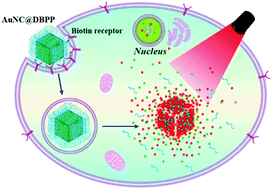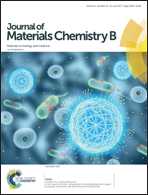Photothermal gold nanocages filled with temperature sensitive tetradecanol and encapsulated with glutathione responsive polycurcumin for controlled DOX delivery to maximize anti-MDR tumor effects†
Abstract
The design of an ideal drug delivery system with targeted recognition and minimized premature release, especially controlled and specific release that is triggered by endogenous and exogenous dual-stimuli, is a great challenge. A biotin receptor-targeted, near-infrared (NIR) irradiation and redox responsive nano-system has now been developed. The nano-system was constructed by filling the interior of Au nanocages with doxorubicin as a chemotherapy agent trapped in tetradecanol, followed by surface conjugation of biotinylated poly(ethylene glycol)–poly(curcumin-dithiodipropionic acid) (Biotin–PEG–PCDA) as a macromolecular chemosensitizer. Once the nano-system had been delivered into MCF-7/ADR cells by biotin receptor mediated recognition and endocytosis, drug release was triggered by degradation of PCDA via a glutathione induced redox reaction in combination with a solid–liquid change of tetradecanol by photothermal effects under NIR irradiation, which could minimize premature drug release and then maximize the therapeutic efficacy.



 Please wait while we load your content...
Please wait while we load your content...